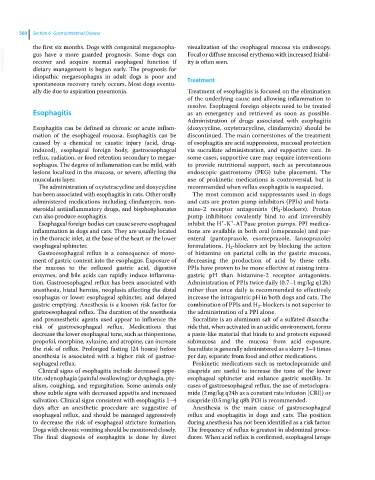Page 592 - Clinical Small Animal Internal Medicine
P. 592
560 Section 6 Gastrointestinal Disease
the first six months. Dogs with congenital megaesopha- visualization of the esophageal mucosa via endoscopy.
VetBooks.ir gus have a more guarded prognosis. Some dogs can Focal or diffuse mucosal erythema with increased friabil-
ity is often seen.
recover and acquire normal esophageal function if
dietary management is begun early. The prognosis for
idiopathic megaesophagus in adult dogs is poor and Treatment
spontaneous recovery rarely occurs. Most dogs eventu-
ally die due to aspiration pneumonia. Treatment of esophagitis is focused on the elimination
of the underlying cause and allowing inflammation to
resolve. Esophageal foreign objects need to be treated
Esophagitis as an emergency and retrieved as soon as possible.
Administration of drugs associated with esophagitis
Esophagitis can be defined as chronic or acute inflam- (doxycycline, oxytetracycline, clindamycin) should be
mation of the esophageal mucosa. Esophagitis can be discontinued. The main cornerstones of the treatment
caused by a chemical or caustic injury (acid, drug‐ of esophagitis are acid suppression, mucosal protection
induced), esophageal foreign body, gastroesophageal via sucralfate administration, and supportive care. In
reflux, radiation, or food retention secondary to megae- some cases, supportive care may require interventions
sophagus. The degree of inflammation can be mild, with to provide nutritional support, such as percutaneous
lesions localized in the mucosa, or severe, affecting the endoscopic gastrostomy (PEG) tube placement. The
muscularis layer. use of prokinetic medications is controversial, but is
The administration of oxytetracycline and doxycycline recommended when reflux esophagitis is suspected.
has been associated with esophagitis in cats. Other orally The most common acid suppressants used in dogs
administered medications including clindamycin, non- and cats are proton pump inhibitors (PPIs) and hista-
steroidal antiinflammatory drugs, and bisphosphonates mine‐2 receptor antagonists (H 2 ‐blockers). Proton
can also produce esophagitis. pump inhibitors covalently bind to and irreversibly
+
+
Esophageal foreign bodies can cause severe esophageal inhibit the H ‐K ‐ATPase proton pumps. PPI medica-
inflammation in dogs and cats. They are usually located tions are available in both oral (omeprazole) and par-
in the thoracic inlet, at the base of the heart or the lower enteral (pantoprazole, esomeprazole, lansoprazole)
esophageal sphincter. formulations. H 2 ‐blockers act by blocking the action
Gastroesophageal reflux is a consequence of move- of histamine on parietal cells in the gastric mucosa,
ment of gastric content into the esophagus. Exposure of decreasing the production of acid by these cells.
the mucosa to the refluxed gastric acid, digestive PPIs have proven to be more effective at raising intra-
enzymes, and bile acids can rapidly induce inflamma- gastric pH than histamine‐2 receptor antagonists.
tion. Gastroesophageal reflux has been associated with Administration of PPIs twice daily (0.7–1 mg/kg q12h)
anesthesia, hiatal hernias, neoplasia affecting the distal rather than once daily is recommended to effectively
esophagus or lower esophageal sphincter, and delayed increase the intragastric pH in both dogs and cats. The
gastric emptying. Anesthesia is a known risk factor for combination of PPIs and H 2 ‐blockers is not superior to
gastroesophageal reflux. The duration of the anesthesia the administration of a PPI alone.
and preanesthetic agents used appear to influence the Sucralfate is an aluminum salt of a sulfated disaccha-
risk of gastroesophageal reflux. Medications that ride that, when activated in an acidic environment, forms
decrease the lower esophageal tone, such as thiopentone, a paste‐like material that binds to and protects exposed
propofol, morphine, xylazine, and atropine, can increase submucosa and the mucosa from acid exposure.
the risk of reflux. Prolonged fasting (24 hours) before Sucralfate is generally administered as a slurry 3–4 times
anesthesia is associated with a higher risk of gastroe- per day, separate from food and other medications.
sophageal reflux. Prokinetic medications such as metoclopramide and
Clinical signs of esophagitis include decreased appe- cisapride are useful to increase the tone of the lower
tite, odynophagia (painful swallowing) or dysphagia, pty- esophageal sphincter and enhance gastric motility. In
alism, coughing, and regurgitation. Some animals only cases of gastroesophageal reflux, the use of metoclopra-
show subtle signs with decreased appetite and increased mide (2 mg/kg q24h as a constant rate infusion [CRI]) or
salivation. Clinical signs consistent with esophagitis 1–4 cisapride (0.5 mg/kg q8h PO) is recommended.
days after an anesthetic procedure are suggestive of Anesthesia is the main cause of gastroesophageal
esophageal reflux, and should be managed aggressively reflux and esophagitis in dogs and cats. The position
to decrease the risk of esophageal stricture formation. during anesthesia has not been identified as a risk factor.
Dogs with chronic vomiting should be monitored closely. The frequency of reflux is greatest in abdominal proce-
The final diagnosis of esophagitis is done by direct dures. When acid reflux is confirmed, esophageal lavage

